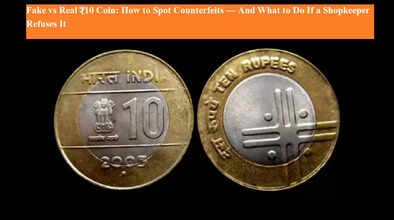Fake vs Real ₹10 Coin: How to Spot Counterfeits — And What to Do If a Shopkeeper Refuses It

Rumors about counterfeit ₹10 coins have left shoppers and shopkeepers confused across India. While some people now inspect every coin—counting grooves, checking the rupee symbol or the placement of the country name—the Reserve Bank of India (RBI) says most worries are misplaced. Here’s a clear, practical guide to tell genuine ₹10 coins from fakes and what steps to take if a merchant refuses to accept one.
Why people are suspicious of ₹10 coins
Recent social chatter and viral posts have claimed that newer and older ₹10 coin designs are being faked. Because coin designs have changed over the years, many users assume any difference means forgery. That’s not correct. Coins are issued by the Government of India and the design or edging may change over time — both old and new designs remain legal tender.
How genuine ₹10 coins differ by design (and why that’s OK)
-
Design changes are normal. For example, ₹10 coins issued in 2009 had 15 grooves (reeding) around the rim, while later issues (from 2011 onward) changed the pattern and added the rupee sign above the numeral 10. Both patterns are official and acceptable.
-
Finish and quality matter. Counterfeit coins often try to copy older designs but fall short in metal quality, weight, or fine finishing. Rather than judging only by design, check for weight, crispness of inscriptions, and uniformity in edging.
-
Counting grooves isn’t foolproof. The number of grooves alone doesn’t determine authenticity because genuine mint batches have varied patterns over different minting years.
Easy checks to perform (no lab needed)
-
Compare feel and weight with another confirmed ₹10 coin — fakes may feel lighter or oddly balanced.
-
Examine inscriptions (Ashoka Pillar, ‘Satyameva Jayate’, the word INDIA and the numeral 10) for sharpness — poorly struck or blurred details can indicate a fake.
-
Look for unusual marks or uneven plating — cheap metal finishes, discoloration, or rough edges are warning signs.
-
Test magnetically — most genuine coins are not strongly magnetic; a simple comparison with a known genuine coin helps.
If a shopkeeper refuses your coin — stay calm and follow these steps
-
Don’t panic or spread rumors. Refusal may be out of caution, not proof of forgery.
-
Visit your bank. Banks can inspect suspicious coins and, if needed, forward them to the RBI for testing. If the coin is genuine, the bank will return it to you. If it’s counterfeit, authorities will investigate.
-
Banks must accept legal tender. Financial institutions are obliged to accept valid coins and exchange them for notes. Unwarranted refusal to accept legal tender can attract legal action under relevant laws pertaining to currency.
-
Keep receipts and records of any incident if you suspect unfair refusal; this helps in escalation.
Practical reality: making counterfeit ₹10 coins is rarely profitable
An RTI response from 2018 estimated that minting a ₹10 coin costs several rupees. Over time the production cost has likely risen, making large-scale counterfeiting of low-denomination coins commercially impractical compared with counterfeit notes. That reduces the likelihood of widespread fake ₹10 coin circulation.
Final word: don’t let design changes cause fear
Ten-rupee coins remain legal tender even if their appearance varies by year. RBI and government-issued designs are valid; the safest course is to verify doubtful coins at a bank rather than refusing them in public or sharing unverified claims online. Use simple physical checks, preserve calm if a merchant hesitates, and report persistent problems to your bank or local authorities — that will help stop both actual fraud and unnecessary panic.

